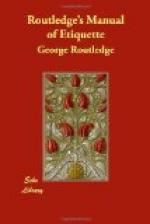Gentleman takes his partner round the waist with his right arm; his left hand holds hers, as in the Polka. Lady places left hand on his shoulder, and right hand in his left hand. Begin at once with the figure en tournant. Time 3/4; one step to each beat. First beat in each bar should be slightly marked by the dancers.
1st beat.—Slide left foot backwards, towards the left.
2nd beat.—Slide your right foot past your left in same direction, keeping right foot behind left, and turning slightly to the right.
3rd beat.—Bring left foot up behind right (one bar).
1st beat.—Slide right foot forward towards the right.
2nd beat.—Slide left foot forward, still turning towards right.
3rd beat.—Bring right foot up to right, turning on both feet, so as to complete the circle (two bars). Remember to finish with right foot in front. Repeat from first beat of first bar. Gentleman always turns from left to right; lady from right to left.
The step of the old Waltz is simple enough; nevertheless some practice is required to dance it really well. Remember always to slide, not to step, forward; for the beauty of this valse consists in its gliding motion. It is not at first easy to dance swiftly and quietly at the same time; but a little patience will soon enable you to conquer that difficulty, and to do full justice to what is, in our opinion, the most perfectly graceful of all the round dances, without a single exception.
* * * * *
XVIII.—THE VALSE A DEUX TEMPS.
We are indebted to the mirth-loving capital of Austria for this brilliant Valse, which was, as we have observed elsewhere, introduced to our notice shortly before the Polka appeared in England, and owed its popularity to the revolution in public taste effected by that dance.
Although the Polka has gone out of fashion, the Valse a Deux Temps still reigns supreme; but within the last two years a dangerous rival has arisen, which may perhaps drive it in its turn from the prominent position which, for more than twenty seasons, it has maintained. This rival is the New Valse, of which we shall speak in its place; but we must now describe the step of the Valse a Deux Temps.




